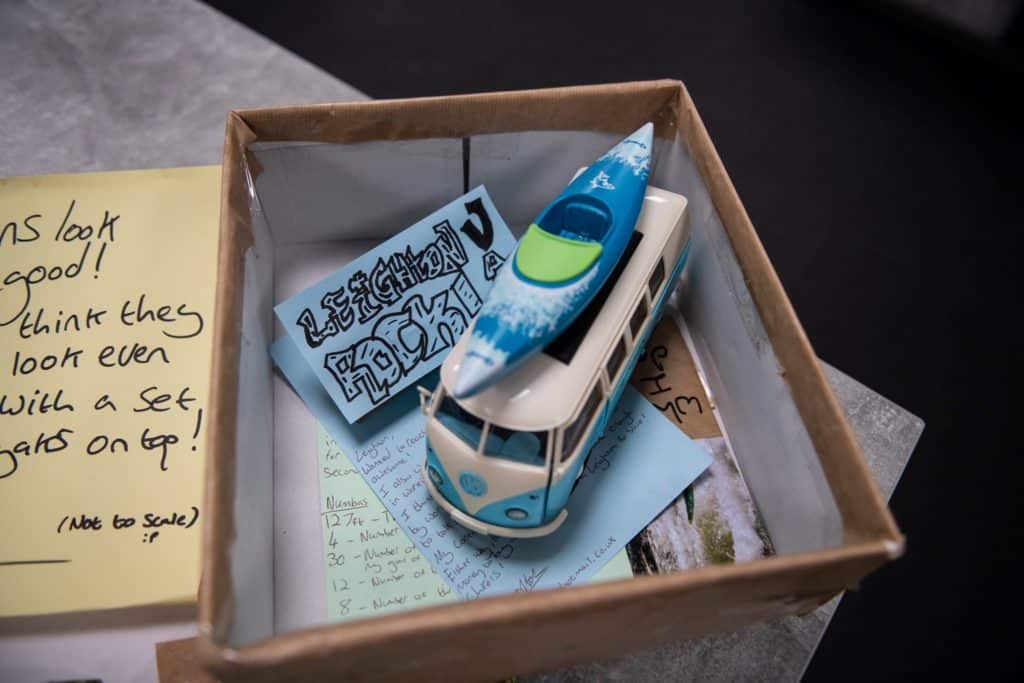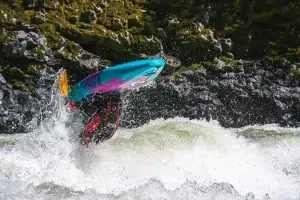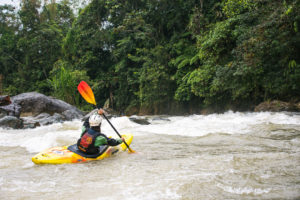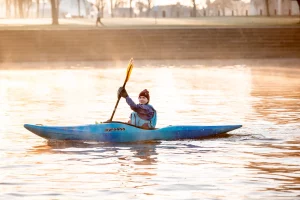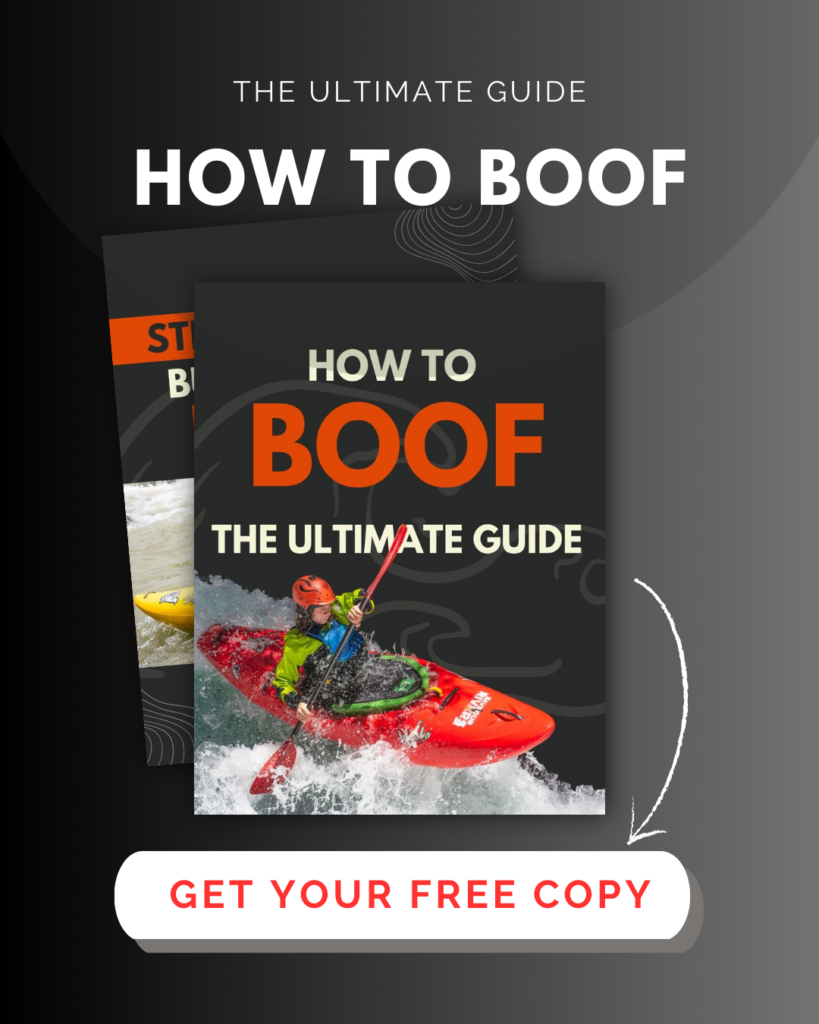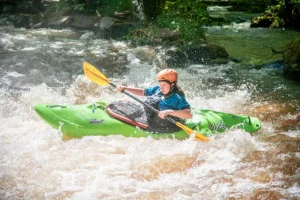The question on many young kayakers’ minds as they watch their heroes send creeks around the world… How do you get sponsored as a whitewater kayaker?
Sponsorship is a partnership between an athlete and a company that aims to raise awareness of the brand or products. There are many things that a company will look at when assessing a sponsorship candidate, predominantly what value will the athlete provide? Successful athletes have a substantial social following, regularly attend events, and have sufficient skills in their chosen sport. You cannot be a sponsored athlete as a beginner in the sport and often athletes will work their way up to better sponsorships over time as they improve and can provide more value to the company.
Why does a company have sponsored athletes
The first thing to consider when looking into sponsorships is why companies have sponsored athletes in the first place! Understanding this can give you a better understanding of how you might be able to get sponsored yourself.
Companies use sponsorships to raise their brand’s profile and as a way of showcasing their products. The company will give the athlete discounted gear or even free gear in return for the promotion of the brand and products. Remember, a sponsorship is not free to the company, the company is making an investment in the athlete as a form of advertising.
A company will also expect the athlete to provide value in other ways. This may be through the review and testing of new products, to gain feedback that will be used to make future products better. This could be the testing of a prototype, helping with the design process or just providing feedback on how the product operates. Another way an athlete can add value directly to a company is by providing media for use in promotions and advertisements. For example, an athlete may provide photos for use on the brand’s social media or website. If the company has a blog then the athlete might be expected to write a certain number of blogs to help drive traffic to the company’s website.
Pros and cons of sponsorship
The pros to sponsorship are fairly obvious. Cheap or free gear which otherwise might break the bank and access to new prototype gear to test are both great incentives. A salary or paid expenses are another huge benefit to certain athletes. Although you have to be realistic about the level of sponsorship you might receive, sponsorship will generally positively benefit the athlete financially, even if in a small way. The athlete may also receive exposure from the brand’s supporters and this can allow the athlete to raise awareness of their personal brand and social media.
The negatives to sponsorship are less obvious but should be carefully considered before jumping into a brand deal. One negative is that you will be restricted to only using that one product. For example, if you were sponsored by the kayak manufacturer Pyranha, then you will only be able to use their boats. This may not be a problem if you love the designs, but if they have a design you do not like, you may be expected to promote it, which can be difficult. Or, if you prefer a piece of equipment from a different brand then you will not be able to use that. This means that you can no longer mix and match the gear of different companies, which means that you may be paddling with gear that you like less than you thought. Ben Marr for example, doesn’t have a set boat sponsor, despite his ability and reputation, so that he can paddle whatever boat he wants!
Another negative is that there is a commitment aspect to a sponsorship. People seem to believe that sponsorship is no effort at all, however, depending on the level of sponsorship and the agreement with the brand the company may expect a lot from you. For example, the brand may expect you to write one blog a month, or create other content such as YouTube videos. The brand may expect you to be at events that you may not want to go to, and this can end up being a substantial amount of work. At the end of the day, it costs the company to sponsor you, so you need to be able to provide value to the company in return.
Types of sponsorship
There are two main types of sponsorship for athletes. The first, and most common, form of sponsorship is where the athlete is given discounted or free gear in return for promotion of the product/brand, and providing feedback on the product for future product development. This is also known as an ambassadorship. The second, and most sought-after, is where the athlete is paid an amount to promote the company. This is almost like a marketing expense for the company, the athlete will become a walking (or paddling) advertisement. This is much harder to achieve and will only be offered by large companies to the athletes at the top tier of the sport. Companies will also often pay for expenses and travel for an athlete to attend an event, for example, a race, where the athlete will provide a lot of exposure to the brand.
Sponsorships will often be tiered and an athlete will work their way up to the higher levels of sponsorship. This may be, for example, 10% off gear at the lowest tier, 20% at the next, up to an allocated budget of free gear for the most successful sponsored athletes. If the company believes the athlete is providing enough value then a monetary sponsorship may be offered, in the form of a salary or paid for travel and expenses for events.
What are your motivations for getting sponsored?
One thing you should consider when you’re looking to get sponsors is what is your motivation to become a sponsored athlete. if you only looking to come sponsored athlete to raise your reputation or because you think it will be cool, then sponsorship is probably not for you. There are a lot of people in the sport who only want sponsorship because of the discounted gear and the reputation they think it may give them. This is not what companies are looking for.
The most important thing you can do to increase your chance of getting sponsored is to go out and paddle more. Companies will only sponsor athletes of a certain standard and who are advocates of the sport. Sponsorship should never be the main goal, the main goal of the athlete should be to get out and have fun in the sport they love.
What can you offer?
When you are applying to a company for a sponsorship, you need to consider what you can bring to the table. How can you benefit the company enough to convince them to want to invest in you?
The worst thing you can do is approach a brand and not have an answer to this question. The classic, “I’ll post to Instagram wearing your gear and you’ll get exposure” won’t cut it – especially if you only have 50 followers. So, what is something you can provide to the company? Do you participate in well-known sporting events? Are you winning races? Do you have a substantial social following? Can you write a blog or create YouTube videos?
There are many ways in which you can create value for a brand, and you should have this prepared when approaching a company. It is a good idea to present this first to a company before you ask for something, as this shows that you’re willing to put the work in, will prove that you’re not just asking for free stuff, and will identify the value that you will provide them.
Build a following.
One of the best ways to get noticed by a brand is to build a social media following. This can be done on any social account, such as Instagram, YouTube, Facebook, etc. The more followers and people you have who support your journey the higher the chance you will be noticed and be able to provide value to a brand.
Although social media is not everything, the company will be able to get more value from you if you have a substantial following behind you. Your posts featuring their products will get more eyes on them the larger the following and therefore the more valuable this will be to the brand.
Be creative!
One of the best ways to get noticed by a brand is by making yourself stand out. This can be through social media, by posting high-quality content, or by doing something that other people are not. This can also be through direct contact with a brand. A great example of this is when Bren Orton sent a package to Leighton Vans, a van hire company in the UK, containing a model van with a kayak on top with some photos explaining what he does. This is a great way to get noticed and shows commitment to the brand and the lengths you’re willing to go to get work together.
Other ways to get noticed could be writing a blog about a company’s gear, making a creative YouTube video, or sending a physical or virtual resume. Companies get hundreds of applications a day through poorly worded emails and DM’s that automatically rule you out as a candidate. Be professional, be creative and find a way to stand out from the crowd.
Create a relationship with the brand
One of the best ways to get noticed in the industry is by building a relationship with a brand you believe in. This can be achieved through posting about their content, commenting on their social posts, and if you are at events, interacting with their teams. In such a small sport as kayaking, word of mouth travels far, and interacting with the brand’s athletes, ambassadors and the people behind the brand is a great way of getting to know the brand and its values. Most athletes are recommended by other athletes or through interactions at events, so consider how you act at events and to other people. This said, don’t try to ask for sponsorship from the staff whilst at events – this will come across poorly and you could get a bad reputation fairly quickly, especially if you are going from stall to stall to ask for sponsorship.
What have you done?
Another thing you should consider is what you have done in the past that shows your worth to the brand. For example, if you compete, where and where did you place? Companies are more likely to take you seriously if you are a successful athlete in your field.
If you don’t compete, do you travel? Do you attend events and interact with other kayakers a lot? Do you run expeditions or attempt first descents. The brand you are looking to work with is going to be looking for someone who can inspire other athletes in the sport. You do not have to be the best paddler to be sponsored, but if you are not then you will have to bring something else to the party. Do you actively encourage diversity in the sport? Are you an advocate for the environment? Make sure you consider what value you can bring to the brand.
What are your plans?
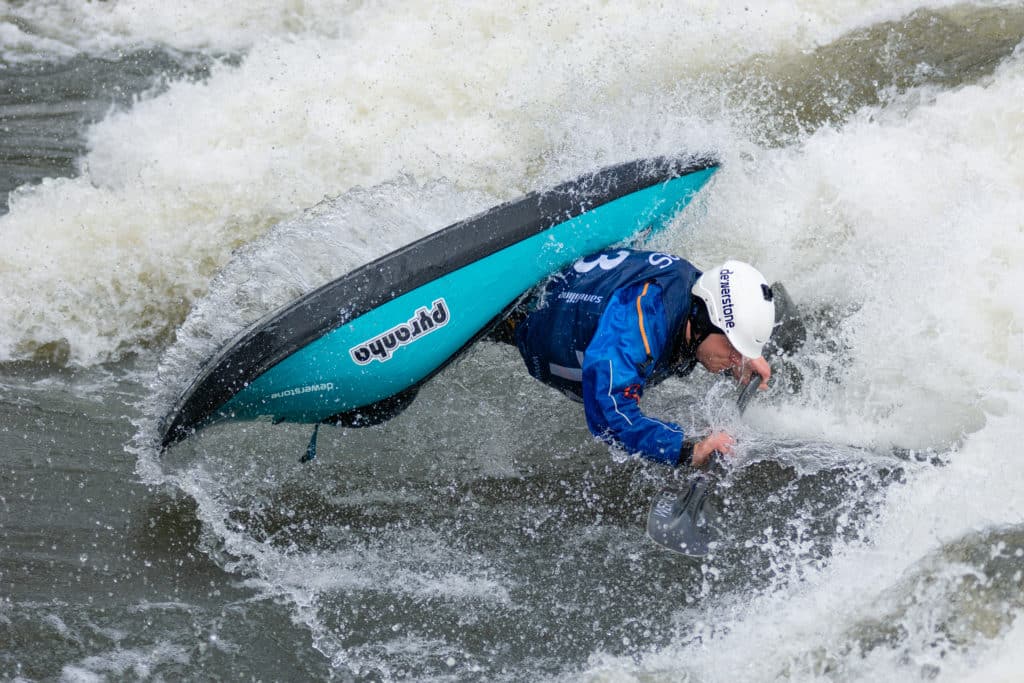
Paddler: Bren Orton – Photo: Jack Grace
Similar to what you have done, another consideration is what are you planning to do. Maybe you are in the lead-up to competing for the world freestyle championships or planning an expedition to an unexplored country. Pitch your ideas to the company, but make sure they are concrete plans and not something that you say just to get on board as this will quickly lead to a soured relationship.
Again, you do not have to be the best athlete, perhaps, you are planning a race or an event to encourage diversity in the sport. Community is a huge part of whitewater kayaking and this can be a large part of a company’s decision to sponsor you.
Should you approach a brand or wait for a brand to approach you?
Most kayaking brands will approach an athlete they want to sponsor, so it is much more important to build a relationship with a brand than focus on reaching out and the sponsorship will come in time. However, if you do want to reach out to a brand then a friendly, professional, and personal email addressed to the correct person is a good way to get started. You can try more creative ways but stay professional, a simple “will you sponsor me?” DM is unlikely to get anywhere.
If you do reach out to a brand then make sure you present yourself in the correct light, if nothing else it may help to get yourself on the brand’s radar, as long as you approach it correctly.
